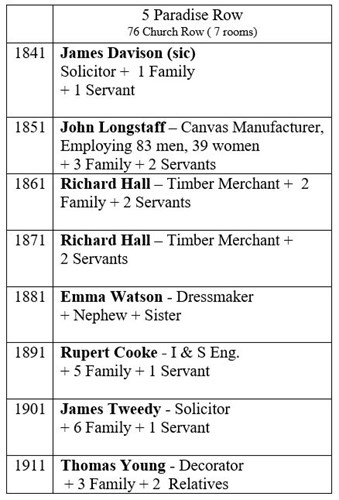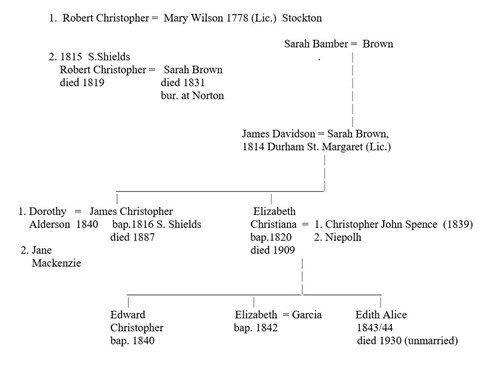New readers may benefit from looking at the earlier parts of this series about Paradise Row (Church Road), especially the introduction. Diagram 1 shows the current location of this street with numbers 5 and 6 highlighted in red.

It seems that numbers 5 and 6 Paradise Row may have been 1 property, originally. Bayley refers to Thomas Troy living in 5 and 6 when it was one house, sometime before Robert Christopher. The sixth article in this series will give a little more information about Thomas Troy. According to Bayley 3 the creation of two properties took place when the Davidsons inherited Robert Christopher’s estate sometime after his death in 1819. Sarah Christopher (widow of James Davidson and also of Robert Christopher) died in 1831 (buried at Norton).
Photograph 1 shows a recent image of 5 and 6 Paradise Row together with some architectural annotations.

Key to photograph 2
1. Symmetry e.g. balanced positioning and size of windows, doors etc
2. Pedimented and panelled doors often with classical pillars/pilasters and fanlights
3. Sash windows
4. String courses
5. Parapets
6. Quoin stones
Note the roof line for numbers 5 & 6 is similar in height to 7 on the right, but lower than 4 to the left. This could suggest that numbers 5, 6 and 7 were built earlier than 4 and possibly for and by different people.
It is also possible that numbers 5, 6 could be one of Douthwaite’s buildings as marked on Pattison’s map of 1722 and Sutton’s drawing of 1792 or that at least they are built on the same site.
Table 1 shows a summary of those resident in 5 Paradise Row for each census 1841 to 1911. Remember that resident does not necessarily mean owner.

Note that :
1. Some of the residents were relatively wealthy and well- known families e.g. James Davidson 1841.
2. Some of the heads of the households had professional jobs reflecting a good education e.g. solicitors
such as James Tweedy 1901.
3. Some of the heads of households had their own business e.g. Richard Hall Timber Merchant 1861 & 1871.
4. Most of the households had servants e.g. John Longstaff 1851.
5. Some of the families had other relatives living with them e.g. Emma Watson 1881.
The rest of this article looks at two occupants of number 5, in the period between 1841 and 1871.
A family split
James Christopher Davidson was baptised in South Shields 1 on January 1st, 1816. His father, James Davidson was a physician/surgeon and had married Sarah Brown at Durham 1 (St. Margaret’s church) 22nd November, 1814. Sarah Davidson’s mother, a widow, married Robert Christopher 1, of Stockton, at South Shields in 1815…a second marriage in each case. James Davidson had been baptised in Harbottle, Northumberland 1 in 1789, the son of Samuel and Christina. Sadly, James Davidson 1 died in 1820 shortly after his daughter Elizabeth Christiana was born in 1820 and when his son was only 4 years old.
Robert Christopher died in 1819 at Stockton 2 and as he had no children he left his considerable estate to Sarah, his second wife. Bayley 3 reckoned that Robert Christopher made his fortune “by shipping and other speculations” rather than his trade as a bookbinder/bookseller. Bayley 3 also states that Robert Christopher owned 3 houses in Paradise Row which later became 3 + 4, 5 + 6 and 7 as the 1841 Census shows. On Sarah Christopher’s death 2 in 1831 aged 66 the estate (property and trusts) had passed to the Davidson family, eventually reaching James Christopher and his sister, Elizabeth Christiana. See diagram 2.

Elizabeth Christiana married Christopher John Spence 2, a timber merchant on 26th January, 1839 at Stockton. Spence was born 8th February, 1810 at Bishopwearmouth 1. His father, also a merchant was John Spence. On 17th August 1840 at Stockton, James Christopher Davidson married Dorothy Alderson 2. By 1843 Elizabeth Christiana was expecting her third child, following the birth of Edward Christopher in 1840 and Elizabeth 2 in 1842 but all was not well. Spence had financial problems and his wife accused him of adultery and immorality and she, a protestant, objected to his conversion to Catholicism 4. With her brother’s alleged involvement, she absconded with her children to a destination unknown…she was witnessed boarding a train at Darlington 4 on 14th September 1843. Despite much effort e.g. offering a reward (1844) for information and including a court case (1847) before the Lord Chancellor in London, Christopher John Spence failed to recover his children. The initial court session recognised his right to have access to his children and made an order against James Christopher Davidson, his brother-in-law, and William Newby (solicitor) to return the children or at least say where they were. Davidson and Newby, as solicitors, were trustees of Mrs. Spence’s settlement and were making interest payments to her. However, on appeal, the judgement was overturned, as Davidson and Newby swore they did not know of the mother’s whereabouts (except she was abroad) and they had not advised her to leave. Davidson also took the opportunity to make further damaging allegations about Spence’s behaviour. For those interested in the details, reports of the court case are readily available online 4.
Research reveals that Elizabeth Christiana eventually arrived in Cape Town. Her death record of 1909 gives her as a widow (she had married Johannes Niepolh) of Meade Street, George (near Cape Town). Her death record is signed by Edith Alice Spence (her 3rd child) and also lists Elizabeth Garcia (nee Spence) her first daughter 9. Christopher John Spence was declared bankrupt in 1849. He died 4th August, 1851 at
Bishopwearmouth following an altercation with Joseph Buchanan, another merchant, in a public house. Buchanan was subsequently charged with manslaughter and appeared at Durham Crown Court in March 1852. The jury declared it was an accidental death and Buchanan was acquitted with a strong reprimand from the judge on the dangers of drink 4. Details about Spence’s son, Edward Christopher apart from his birth in 1840 have so far proved elusive.
James Christopher Davidson also went to Cape Town where he was for a time (1864 – 72) Treasurer General of the Colony of the Cape of Good Hope. Like his sister he also married a second time…his widow Jane Mackenzie Davidson signed the death notice 9. Interestingly, he died 5 in Hastings, Sussex, 11th January 1887. His personal estate amounted to a little under £2000.
An interesting footnote is that Edith Alice Spence 9 died, unmarried in 1930 at her home in Meade Street, George (near Cape Town). The death notice says she was born in England …..and it is signed by a Catholic priest, present at her death !
Another timber merchant
Richard Thomas Hall’s family is another example of the many cases of migration to Stockton by people looking to improve their prospects by taking advantage of the opportunities available. Richard’s father William was born in Easington 1 (near Loftus) in the North Riding. He was one of at least 6 children born to Thomas and Sarah Hall at Easington between 1780 and 1790. Easington parish then, was largely agricultural with a population of about 500. William, born in 1785, married Rachel Child 1 at nearby Brotton on June 04th, 1818 and Richard Thomas was born soon after in 1819. His baptism record at Great Ayton, 23rd May 1819 gives his father, William as a farmer at Nunthorpe 6. Exactly when the Hall family moved to Stockton is uncertain, but Richard’s brother John 2 was baptised July 2nd 1830 at Stockton. Isabella (1832) and his brother William Child (1837) were both born at Norton 7. In each case the father William is shown as a farmer. The 1841 census 7 records the family living in the High Street at Norton with William an innkeeper and Richard a clerk. In 1851, Richard (timber merchant) along with Isabella and William jun. was living at 150 High St. in Stockton 7 on a site now occupied by Debenhams. Meanwhile, William sen. a retired farmer was living with his wife in Stockton Road, Norton.
Newspaper 4 reports suggest that Richard’s timber business (like a number of others), lay near the bridge and the route of the new railway. At the time, there were extensive timber yards in Stockton especially near the old bridge over the Tees and they were an important part of the town’s economy. By 1861 Richard 7 and his siblings had moved to 5 Paradise Row. Richard was a timber merchant and William, his clerk. Isabella was the housekeeper. There were two servants. So they appear to have been doing quite well. At this time, William sen. had moved to Thornaby and lived near the pottery, with his wife and a servant 7. The 1871 Census records Richard still living at 5 Paradise Row, but without his siblings 7.
How Richard became involved in the timber trade is unclear, but a partnership with John Robinson 4 may have been significant, although it was dissolved around 1856. On a number of occasions, Richard Hall actively pursued debtors in the courts e.g. William Smith a bankrupt shipbuilder at South Stockton, and Thomas Laverick of Witton-le-Wear, a builder (1857) 4.Trade directories 8 regularly listed the business between 1850 and 1870. Richard’s business activities no doubt helped him to become a councillor (1852 N.W. Ward), a provisional director of the proposed Stockton & Stokesley railway (1854) and a grand jury member for Durham Assizes (1861) 4. However, not everything ran smoothly. In 1863, Richard not only dismissed his employee of 14 years, Joseph Warwick who managed Hall’s timber yard in Coatham, Redcar, but took him to court for embezzlement 4. Warwick was found guilty and given a sentence of 8 months in jail. In 1866, Richard himself was fined and charged costs for striking a lawyer’s clerk, William Doble, who was attempting to serve a writ on him (Stockton Petty Sessions). In 1867 Hall’s premises in Coatham were put up for sale and in 1872 he was in the Stockton borough police court , this time accused of causing wilful damage in a case brought by Miles Cadle (ironmonger). This case was dismissed 4.
Except it seems for Isabella, all of the Hall family were buried at Norton, St. Mary. John died in 1850 aged 19. William, died in 1863 (aged 78). William Child, who was lodging in Bridge Road (1871 census), died in March 1872 (aged 35). In 1871 (Census), Rachel Hall 7, Richard’s mother, was living as an annuitant at 10 Archer St., Thornaby. She died in 1873 aged 78. A newspaper report of 11th September, 1874 announced a final notice to creditors suggesting the business was no longer operating. Richard Thomas Hall died aged 55 in 1875 (Guisbrough Reg.Dist.) 5 and was buried at Norton (St. Mary). The Norton burial 2 records give Richard’s abode as Redcar (Coatham).
Detailed consideration of Hall’s timber business is beyond the scope of this article. However, with the benefit of hindsight it would appear that Richard Thomas Hall may have joined the timber business in Stockton after its peak, certainly in terms of supplying the shipbuilding industry following the advent of the use of iron ( post 1850 according to Sowler).
REFERENCES
General :
A. Sowler, Tom “A History of the Town and Borough of Stockton-on-Tees” 1972
B. Richmond, Thomas “Local Records of Stockton-upon-Tees and Neighbourhood” 1868
C. Brewster, John “The Parochial History and Antiquities of Stockton upon Tees 1796”
“The Parochial history and antiquities of Stockton upon Tees 1829”
D. Heavisides, Henry “The Annals of Stockton-on-Tees with biographical notes” 1865
More specific :
1. See www.familysearch.org.
2. See parish records at Stockton Library.
3. Online “GENEALOGICAL ADDITIONS TO THE HISTORY OF
STOCKTON UPON TEES” W.D.Bayley 1848.
4. Online at www.findmypast /newspapers.
5. Online at www.freebmd.org.uk
6. Transcriptions at www.greatayton.wikidot.com/parish-registers
7. See www.ancestry.co.uk.
8. Trade directories e.g. online at www.specialcollections.le.ac.uk/
9. See www.familysearch.org. records for S. Africa, Cape Province
